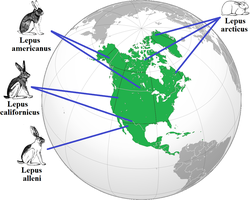
Allen's rule is an ecogeographical rule formulated by Joel Asaph Allen in 1877,[2][3] broadly stating that animals adapted to cold climates have shorter and thicker limbs and bodily appendages than animals adapted to warm climates. More specifically, it states that the body surface-area-to-volume ratio for homeothermic animals varies with the average temperature of the habitat to which they are adapted (i.e. the ratio is low in cold climates and high in hot climates).
- ^ FRYDRÝŠEK, Karel (2019). Biomechanika 1. Ostrava, Czech Republic: VSB – Technical University of Ostrava, Faculty of Mechanical Engineering, Department of Applied Mechanics. pp. 338–339. ISBN 978-80-248-4263-9.
- ^ Allen, Joel Asaph (1877). "The influence of Physical conditions in the genesis of species". Radical Review. 1: 108–140.
- ^ Lopez, Barry Holstun (1986). Arctic Dreams: Imagination and Desire in a Northern Landscape. Scribner. ISBN 978-0-684-18578-1.